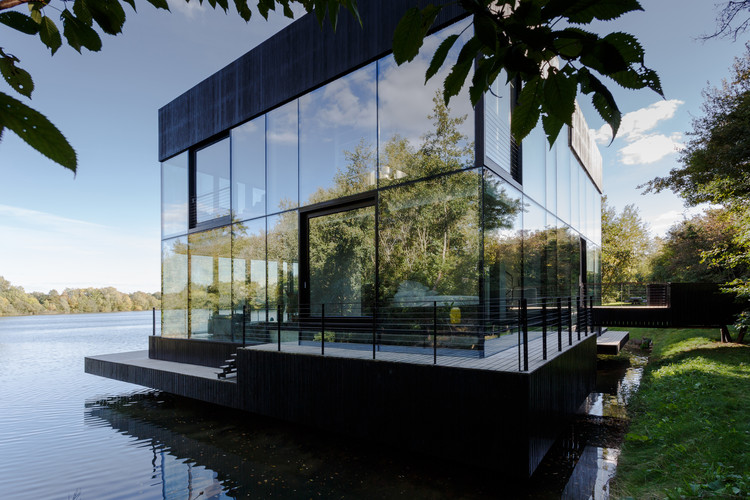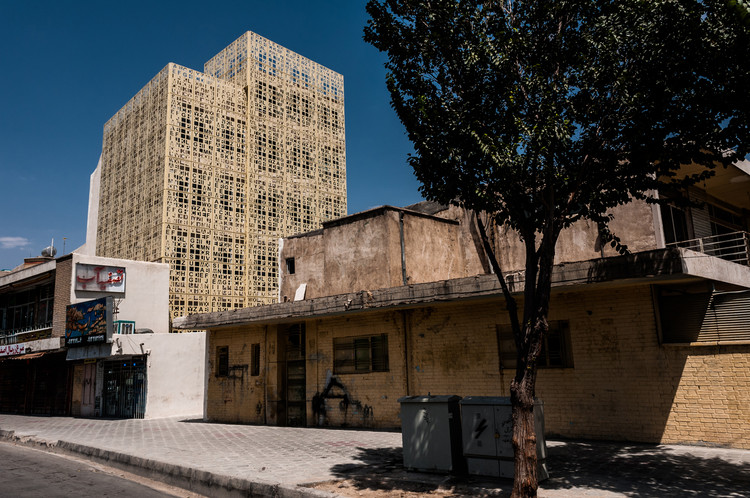Kangka Zhouzhuang Tourist Resort Aquatic Club UDG China
2014-04-11 01:00
架构师提供的文本描述。该遗址位于周庄北部,素有“中国第一个水乡”之称。水上俱乐部包括两栋楼:康佳的销售屋和办公楼,服务于康佳集团800英亩的房地产开发。在充分研究文化、环境、气候和地方建筑的基础上,我们选择了中国现代建筑风格作为设计取向,重点研究了空间语言从传统到现代的转换。
Text description provided by the architects. The Site is located in the north part of Zhouzhuang which is known as “China’s First water town”. The aquatic club includes two buildings : sale house and office building of Konka, serving for 800 acres’ real estate development of the Konka Group . With sufficient research of the culture 、environment、climate and local buildings, we choose modern Chinese architectural style as design orientation, focusing on the transformation of spatial language from traditional to modern .
这两座L形建筑组成的建筑群围绕着一个内部的庭院,反映了中国传统四合院建筑的古代空间哲学。单坡屋顶延伸到湖面的趋势正好相反,屋檐很深。这不仅体现了传统建筑的深邃宁静,同时也彰显了滨水建筑的敏捷和典雅品质。
The group of these two L-shaped buildings enclose a interior ourtyard, reflecting the ancient space philosophy of Chinese traditional courtyard buildings. Single slope roofs expand to the lake with exactly the opposite trends ,with deep overhang eaves. This not only expresses a profound tranquility of traditional architecture, but also hightlights a agile and elegant quality of waterfront buildings.
我们从南方传统建筑中提炼出设计理念,通过巧妙地处理建筑、庭院、水的关系,运用封闭、半透明、透墙的设计语言,体现“华南水乡”和“中国古典园林”的独特魅力。灵活运用水景。随着金属砖、粘土管、空心砖等特色材料的创新应用,我们成功地再现了上述独特的魅力。
We get the concept for the design from traditional architecture of South China , in order to reflect the unique charm of “Water Town Of South China” and of“Classical Chinese Garden “,by means of ingeniously dealling with the relationship among the building, courtyard and water ,as well as using the design languages of enclosed and semi-enclosed courtyard、translucent and thoroughly walls、flexible usage of water scene. With innovatively applications of metal-tile、 clay pipes、hollow bricks and other characteristic materials, we successfully recreate the unique charm as we talked above.
一种自行开发的金属瓦,被我们的主要建筑师命名为“李娃”,它被创造性地应用于围护庭院周围的建筑外墙上,“李娃”是在现代标准化的工业生产过程中生产的,它保留了中国传统瓷砖的造型和顺序。通过在1mm厚镀锌钢板上切割间断线,分别上下滑动,形成自然弧形件,并最终由钢筋固定。原先在建筑物倾斜屋顶上使用的瓷砖现在被创造性地应用于建筑物正面,这样我们就可以得到适当的遮阳和节能。同时,通过控制钢板的切割尺寸和机组的固定角度,可以得到不同的透气性效果和不同的光影。幕墙与面向湖面的建筑立面上的粘土管道相结合,可以使建筑物的垂直边缘变得模糊,建筑的深层宁静更加明显。
A kind of self-developed metal-tile which is named “Li Wa”by our principal architect is innovatively used on the building façade around the enclosed courtyard.“Li Wa” is Produced in a modern standardized industrial process, which retains the sculpt and sequence of Chinese traditional tiles. By cutting discontinuous lines on a 1mm thick galvanized steel sheet, sliding up and down the sides respectively, natural arc-shaped pieces are formed, and ultimately fixed by the reinforcing bars. The tiles which are originally used on the sloping roof of buildings are now creatively applied on the building facade, so that we can get appropriate sunshine-shading as well as energy-saving. Meanwhile, by controlling the cutting size of the steel sheet and the fixed angle of the units, we can get diverse permeability effects and various light and shadow. Combined with clay pipes on the building facade facing the lake , the curtain walls can make the vertical edge of the building vague and the profound tranquility of architecture evident.
Location Zhouzhuangzhen, Kunshan, Suzhou, Jiangsu, China, 215325
Architect in Charge Qian Qiang, Li Xiaojian, Bernd Lederle, Feng Haihua, Li Chencheng, Bi Yifei, Tanase yo shoji, Satoshi Morita, Chen Hongbin, Simone De Gradi
 举报
举报
别默默的看了,快登录帮我评论一下吧!:)
注册
登录
更多评论
相关文章
-

描边风设计中,最容易犯的8种问题分析
2018年走过了四分之一,LOGO设计趋势也清晰了LOGO设计
-

描边风设计中,最容易犯的8种问题分析
2018年走过了四分之一,LOGO设计趋势也清晰了LOGO设计
-

描边风设计中,最容易犯的8种问题分析
2018年走过了四分之一,LOGO设计趋势也清晰了LOGO设计
.jpg)

.jpg)

.jpg)



.jpg)

.jpg)

.jpg)

.jpg)

.jpg)

.jpg)

.jpg)

.jpg)

.jpg)

.jpg)

.jpg)

.jpg)

































